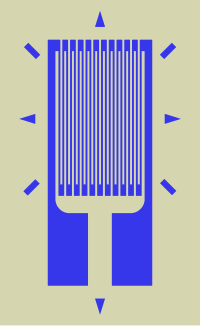
Photo from wikipedia
As as emerging innovation, electronic textiles have shown promising potential in health monitoring, energy harvesting, temperature regulation, and human-computer interactions. To access broader application scenarios, numerous e-textiles have been designed… Click to show full abstract
As as emerging innovation, electronic textiles have shown promising potential in health monitoring, energy harvesting, temperature regulation, and human-computer interactions. To access broader application scenarios, numerous e-textiles have been designed with a superhydrophobic surface to steer clear of interference from humidity or chemical decay. Nevertheless, even the cutting-edge electronic textiles (e-textiles) still have difficulty in realizing superior conductivity and satisfactory water repellency simultaneously. Herein, a facile and efficient approach to integrate a hierarchical elastic e-textile is proposed by electroless silver plating on GaIn alloy liquid metal coated textiles. The continuous uneven surface of AgNPs and deposition of FAS-17 endow the textile with exceptional and robust superhydrophobic performance, in which the conductivity and the contact angle of the as-made textile could reach 2145 ± 122 S/cm and 161.5 ± 2.1°, respectively. On the basis of such excellent conductivity, the electromagnetic interference (EMI) shielding function is excavated and the average shielding efficiency (SE) reaches about 87.56 dB within frequencies of 8.2-12.4 GHz. Furthermore, due to its high elasticity and low modulus, the textile can serve as a wearable strain sensor for motion detection, health monitoring, and underwater message transmission. This work provides a novel route to fabricate high-performance hydrophobic e-textiles, in which the encapsulation strategy could be referenced for the further development of conductive textiles.
Journal Title: ACS applied materials & interfaces
Year Published: 2022
Link to full text (if available)
Share on Social Media: Sign Up to like & get
recommendations!